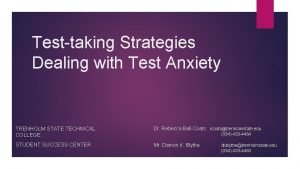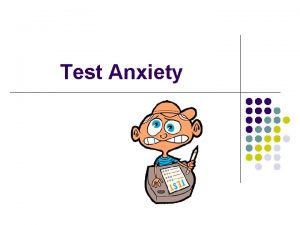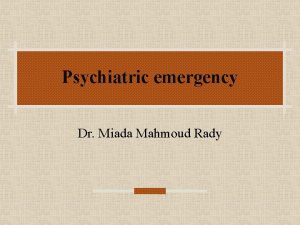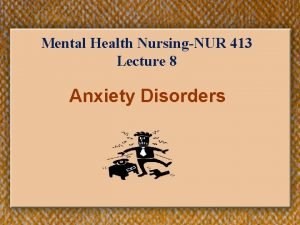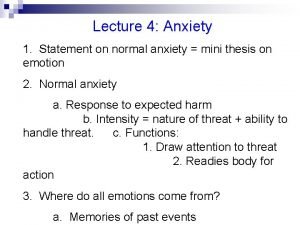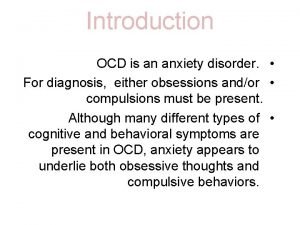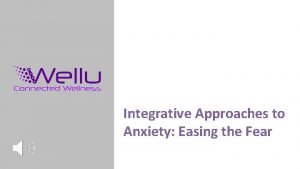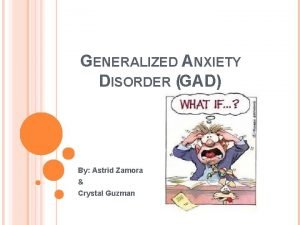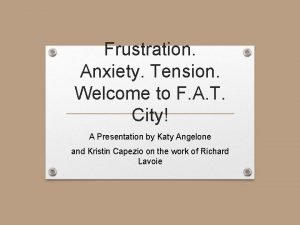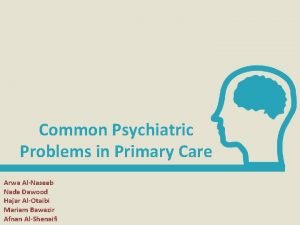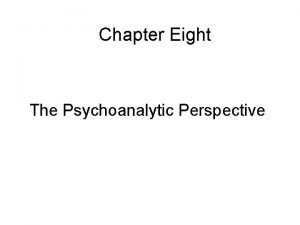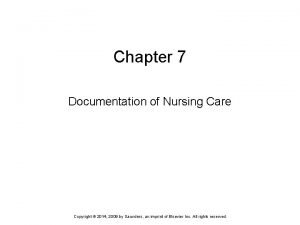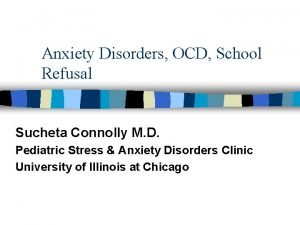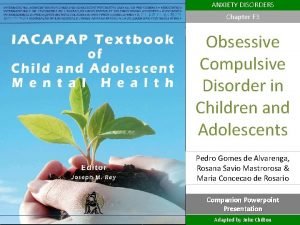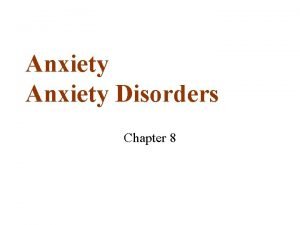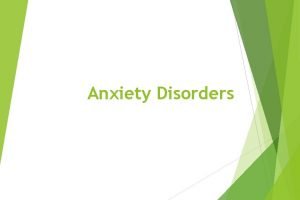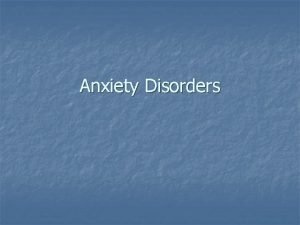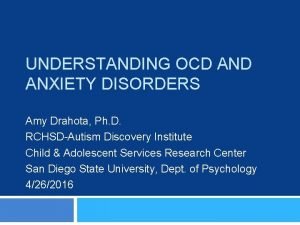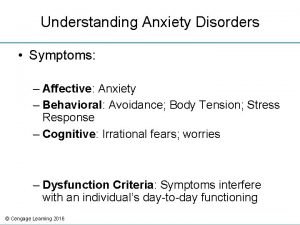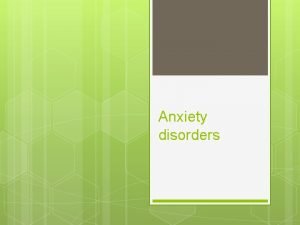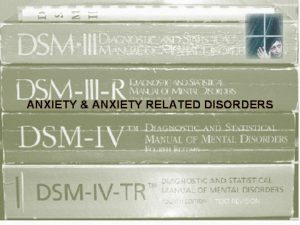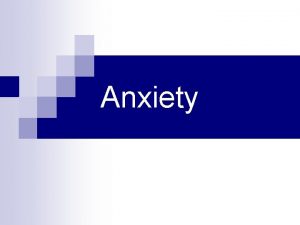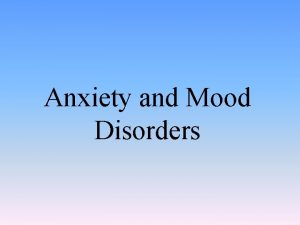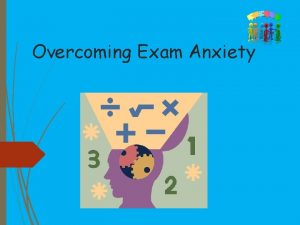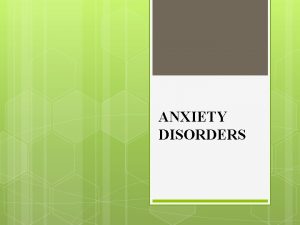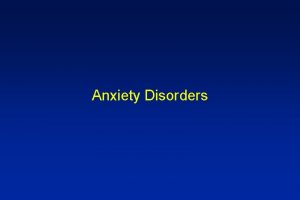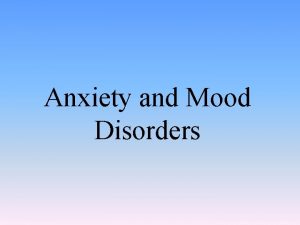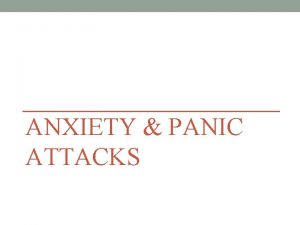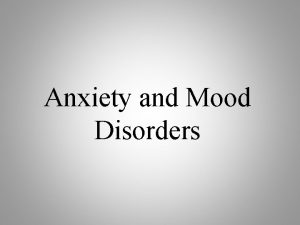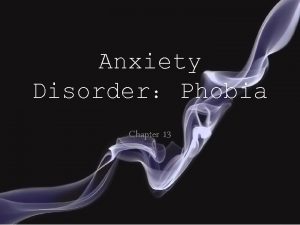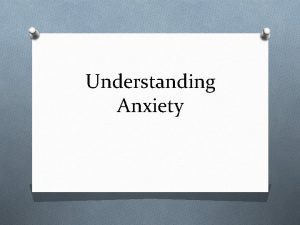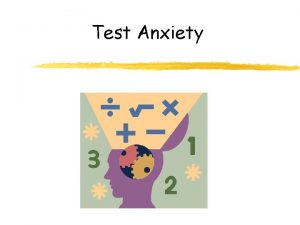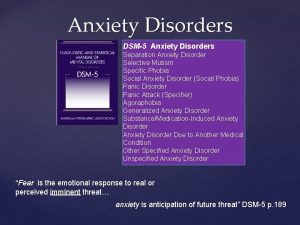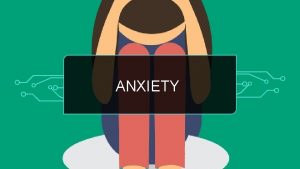Anxiety Plan of session n What is Anxiety


































- Slides: 34

Anxiety

Plan of session n What is Anxiety? n What can you do to help? n Questions

Anxiety is normal, it is a response to stressful or challenging events. n 1 in 6 children suffer from anxiety severe enough to interfere with their day to day activities (Dadds et al 1997) n If left untreated, often persists into adulthood (Anderson 1994) n Anxiety disorders can be prevented when children are given the appropriate skills n


Fight and Flight The brain in the hand! n The impact of cortisol on the body. n

Presentation of anxiety Physical: headaches, stomach aches, vomiting, sleep disturbance, palpitations, chest pain, difficulty breathing, choking sensations (panic attack) Cognitive: unhelpful / unrealistic thoughts, rumination Behavioural: avoidance, disruption & withdrawal. Emotional: excessive fear of something/someone/ situation

Physical discomfort Tense muscles Headache Breathless Dizzy/light headed Face flushed Tight chest Trembling Heart beats hard & fast Sweaty hands Stomach pains/ butterflies Needing the toilet Weak legs Dry mouth/difficulty swallowing Fidget feet Blushing Cool Connections With CBT, 2008, Laurie Seiler

When it becomes a problem When anxiety interferes significantly with everyday life opportunities and experiences n Anxious symptoms dominate the young person, they are unable to do what they used to do or want to do. n When they can’t cope n

Types of anxiety Severe anxiety long standing avoidant behaviours e. g. separation anxiety in children • Phobias marked fear which is not age appropriate i. e. buttons, dogs • Social anxiety/phobia- fear of what other people think of you, or your performance can develop in mid to late teens. ‘Agoraphobia’ is the extreme phobic state of social anxiety •

Types of Anxiety Cont. • • OCD (Repeated unpleasant thoughts i. e. germs) often unreasonable PTSD (recurrent persistent intrusive recollections of event) Generalised anxiety (excessively worried most of the time, interferes in daily activities) Panic attacks are unpredictable acute symptoms, very disabling.

CBT model of Anxiety THOUGHTS BEHAVIOUR EMOTIONS PHYSIOLOGICAL REACTIONS

Situation: You see a dog walking along the road towards you THOUGHT: It’s going to bite me BEHAVIOUR: Cross road quickly EMOTION: I’m frightened PHYSIOLOGICAL REACTION: Shaking, sweaty palms

What maintains anxiety? n Avoidance n Reassurance n Copying others anxious behaviour n Repeated exposure to perceived negative experiences

Child factors Have to say goodbye to Mum to go in to class Parent factors She is not going to be able to cope; Situational factors She is going to get really upset Anxious; Tense A clinical model of the maintenance of anxiety Someone will pick on me Fear Tummy ache Cuddle and try to comfort; Take her home Failure to disconfirm assumptions Cling on to Mum; Refuse to go in Reinforcement of avoidance

ANGER (OR FIGHT) Adrenaline produces energy in our body to give us the strength to fight off a real or perceived danger. For some people the possibility of danger is constantly present leaving them feeling threatened most of the time. They are hyper alert and looking for trouble. This is a protective, instinctive behaviour. Young people in this hyper aroused state need to be soothed and contained in order to feel safe.

Avoidance (or flight) n Safety behaviours, such as avoidance, are actions carried out with the intention of preventing a feared catastrophe. In the short-term they often give a sense of relief, but in the long-term they are unhelpful because they prevent us realising these beliefs aren’t always true and that they are maintaining anxiety.

What is excessive reassurance seeking? n When a child is feeling anxious, he or she will probably turn to you for help in feeling better. One of the ways in which a child might do this is through reassurance seeking, which involves asking you lots of questions, or asking the same question over and over in order to hear from you that things will be okay.

Some examples of reassurance seeking: n n n “Are you sure you locked all the doors? ” “Tell me again that I’m a good girl!” “Did you wash your hands before you cooked dinner? Are you really sure? ” Calling mum or dad over and over again on the phone from school to make sure they are okay. Asking parents to check homework repeatedly to make sure there absolutely no mistakes.

SEEKING OR RECEIVING REASSURANCE FROM OTHERS. It is a natural response to tell an anxious child that everything will be all right. n The problem is, children grow to depend on their adults to solve their problems and miss out the chance to increase their confidence to solve their own problems. n To be the best support, you need to let them do the work/problem-solving, and you remain their guide. n

n To be effective, reassurance should be realistic, sincere, given at the right time, directed at the appropriate target and based on sound grounds (Lau, 1989 - Family Therapist, Canada).

Listening & Encouraging self-assurance, not giving reassurance • Reassurance giving can only reduce anxiety as a very temporary measure. • looking at the evidence of worry thoughts, and taking small action steps towards the fear can boost a child’s ability to re-assure themselves.

What can we do? Try and understand what is behind the child’s behaviour And be a lighthouse not a helicopter!

What can we do? Help the child(ren) to: n n n Emotional: express their feelings and learn ways to manage them Physical: recognise their body cues learn to do deep breathing and relaxation exercises Cognitive: distraction, positive self talk, challenge distorted thoughts by treating thoughts as just thoughts & not facts

What can we do cont…? n Behavioural: - model appropriate management of feelings, reduce excessive reassurance and encourage self-assurance encourage the child to gradually face up to their fear and not avoid situation – step plan of exposure, with rewards -

What can we do? Positive self talk or inner thoughts Problem solving Self reward THOUGHTS BEHAVIOUR , Reward systems Exposure Self reward Awareness of body cues EMOTIONS PHYSIOLOGICAL REACTIONS Awareness of body cues Relaxation Deep breathing

Being a Young Person’s guide • • Listen to the young person’s worries in an open, empathic way, without jumping in to comment or offer reassurance Encourage them to answer their own questions Ask them what they think the likelihood is of something bad happening Encourage them to come up with ideas and things that have worked before.

How can Anxiety be Reduced? • • • Visual Relaxation Controlled breathing Muscle relaxation Looking at the evidence & treating thoughts as just thoughts & not facts Facing your fears and not avoiding situations Listening & encouraging self-assurance, not giving re-assurance

Using a Detective’s Approach to Beat Unhelpful Thoughts • Evidence Checklist 1. 2. 3. 4. Has this happened before? What happened then? What other reasons could there be for this happening? How likely is it to happen? What would someone I admire think in the same situation? What would I tell a friend who was in the situation and had the same unhelpful thought? Would I feel better if I changed my thought? How can I cope with the situation? 5. 6. 7.

Facing fears and not avoiding situations • The next step is to take action to face fears. • Taking small steps to begin to re-assure themselves that nothing bad will happen and build confidence.

FACING YOUR FEARS ACTION STEPS CHECKLIST • Identify the fear that the young person wants to beat. Be specific. • Break the fear down into small steps. • Put the steps on to a ladder with the easiest at the bottom and the hardest (the goal) at the top. • Start at the bottom of the ladder • Practice the first step of the ladder a lot until you feel less scared. Then move up to the next step. • Use helpful thinking, looking at the evidence and relaxation to help climb the ladder. • Decide on a reward for success at each step – and also for trying.

MY LADDER FOR BRAVE BEHAVIOURS

General building of good mental health Self-esteem n Problem-solving skills n Psychological resilience n Self expression n Building positive relationships with peers and adults n

Mindfulness n Apps for Mindfulness- Headspace n Mindful Gnats n Mindshift n NHS Choices n

QUESTIONS….
 Nursing diagnosis for panic disorder
Nursing diagnosis for panic disorder Example of a session plan
Example of a session plan How anxiety affects eyewitness testimony
How anxiety affects eyewitness testimony Relaxation techniques test anxiety
Relaxation techniques test anxiety Exam anxiety symptoms
Exam anxiety symptoms I'm a perfect example of someone who has math anxiety
I'm a perfect example of someone who has math anxiety Neurotic anxiety example
Neurotic anxiety example Anxiety mnemonic
Anxiety mnemonic Examples of generalized anxiety disorder
Examples of generalized anxiety disorder Chapter 8 managing stress and anxiety
Chapter 8 managing stress and anxiety Free floating anxiety
Free floating anxiety Ocd vs gad
Ocd vs gad Uw integrative medicine
Uw integrative medicine Examples of generalized anxiety disorder
Examples of generalized anxiety disorder Frustration anxiety and tension
Frustration anxiety and tension Mecbal
Mecbal Generalized anxiety disorder dsm 5
Generalized anxiety disorder dsm 5 Define neurotic
Define neurotic Neurotic anxiety example
Neurotic anxiety example Documentation objectives
Documentation objectives Test anxiety essay
Test anxiety essay Chapter 18 managing anxiety
Chapter 18 managing anxiety Chapter 15 anxiety and obsessive-compulsive disorders
Chapter 15 anxiety and obsessive-compulsive disorders Caregiver anxiety
Caregiver anxiety Levels of anxiety nursing
Levels of anxiety nursing Ocd and school refusal
Ocd and school refusal Ocd behaviors
Ocd behaviors Hildegard peplau levels of anxiety
Hildegard peplau levels of anxiety Apprehensive vs anxious
Apprehensive vs anxious Anxiety disorders def
Anxiety disorders def Generalized anxiety disorder dsm 5
Generalized anxiety disorder dsm 5 Agoraphobia vs social anxiety
Agoraphobia vs social anxiety Peter de maria
Peter de maria Explanation of anxiety disorder
Explanation of anxiety disorder Explanation of anxiety disorder
Explanation of anxiety disorder



